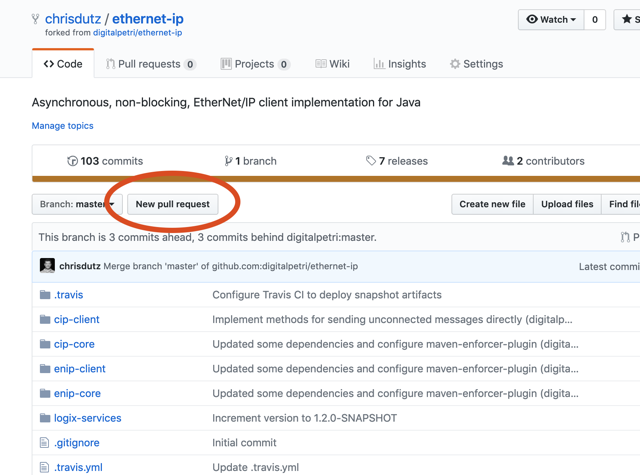Contributing
Forms of contribution
There are multiple forms in which you can become involved with the PLC4X project.
These usually are, but are not limited to:
-
Submitting Pull Requests
-
Filing Bug-Reports
-
Active communication on our mailing lists
-
Promoting the project (articles, blog posts, talks at conferences)
-
Documentation
We are a very friendly bunch and don’t be afraid to step forward.
Commits
We make use of conventional commits.
As plc4x is a monolithic polyglot repository we usually define the scope as …(plc4[language shortcut here]/subcomponent)
(e.g. a new feature in Bacnet in the Golang part would have a message of feat(plc4go/bacnet): cool new feature for…).
Pull-Requests
The simplest way to submit code changes, is via a GitHub pull-request.
In order to do this first create a GitHub account and sign into you account.
After that’s done, please to to our GitHub site and create a so-called Fork.

What happens now, is that GitHub creates a full copy of the PLC4X repo in your account. Only you can commit to this.
Now ideally you check-out your cloned repository:
git clone https://github.com/{your-user-id}/plc4x.git
Now you have a copy of PLC4X on your computer and you can change whatever you want and as it’s your copy, you can even commit these changes without any danger of breaking things.
As soon as you’re finished with your changes and want us to have a look, it’s time to create a so-called Pull-Request.
You do that by going to your forked repository page on GitHub.
Every forked repository has an additional button called "New Pull Request":

If you click on this, we will receive a notification on your changes and can review them. We also can discuss your changes and have you perfect your pull request before we accept and merge it into PLC4X.
Keeping your fork up to date
As we are continuously working on PLC4X and you created a copy of our repo, this will become out-of-date pretty soon.
In order get the changes we introduced in the official repo you have to tell git about that.
You do this locally by adding a new so-called remote.
Per default the remote you cloned from is called origin.
Usually you will call the second remote upstream but in general you can call it whatever you like.
Add the remote on the commandline (or your git gui of choice):
git remote add upstream https://github.com/apache/plc4x.git
If you list all your remotes, with the following command:
git remote -v
It should output something like this:
origin https://github.com/{your-user-id}/plc4x.git (fetch)
origin https://github.com/{your-user-id}/plc4x.git (push)
upstream https://github.com/apache/plc4x.git (fetch)
upstream https://github.com/apache/plc4x.git (push)
If that’s so, you’re fine to continue, if not … well you could ask for assistance on our dev-list.
In order to get all changes of our upstream-repository, just execute the following command:
git pull upstream
This will get all changed from upstream and merge them locally. In order to update your GitHub version, you have to push things back to origin.
You can do this by executing the following command:
git push
(If no remote is provided, git will use origin per default)
Bug Reports
We use JIRA as our Bug & Issue Tracker.
Feel free to submit feature requests, bug reports, patches, comment on issues, …
In order to be able to do so, you need to create an account first.
Currently Apache has a separate login system for JIRA and all other services, this might change in the future, but right now it’s the way things are.
So if you are considering to contribute more than just a one-time-patch, please choose a username that hasn’t been used by an existing Apache committer as this will simplify things if we invite you to become part of the team.
If you want to be assigned to an issue because you want to work on it, please request to be added to the JIRA groups on our developers mailing list
Documentation
As our documentation and website are generated as a side-product of our build, contributing to this technically the same as contributing to the code.
All our content is written in Asciidoctor and is located in src/site/asciidoc directories.
For a reference of the Asciidoctor syntax please have a look at the Asciidoctor documentation.
Branching model
The PLC4X project uses the following branching model.
The same model is used for a wide variety of other projects, so it should be pretty straight forward.
-
releasecontains the latest released state. -
Development is performed on the
developbranch. -
Features are developed in Feature-Branches with a prefix
feature/ -
Each minor release has a corresponding release branch
rel/{major-version}.{minor-version} -
A release branch is spawned from
developonly -
Bugfix releases don’t have a dedicated release branch, they are just performed on the corresponding minor versions release branch